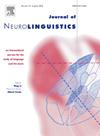增强左额叶中回的脑间同步有利于学习社会互动中的构词规则:一项fNIRS超扫描研究
IF 1.2
3区 心理学
Q2 LINGUISTICS
引用次数: 0
摘要
互动中的沟通影响着新知识的获取,而这些新知识可以被他人分享和理解。然而,这种交流对学习构词法规则的影响还没有得到充分的研究,特别是在社会互动的背景下。目前的研究使用基于功能近红外光谱的超扫描技术来捕捉关于构词法规则的交流如何影响单词学习。材料由在感知显著性层次上较低或较高的假词组成。感知显著性指的是我们的大脑优先考虑我们所感知的事物的方式。层次理论认为,颜色比形状更容易被感知,形状比纹理更容易被感知(即颜色&形状&纹理)。两组学习者在进行相关话题的交流后,学习构词规则的准确性有所提高,这也引起了左额叶中回和右额叶上回的脑间同步性增强和表征相似性提高,从而提高了协作和协调能力,特别是在学习困难的构词规则时。总之,这些发现表明,在社交互动中,就相关话题进行交流有利于词汇学习。本文章由计算机程序翻译,如有差异,请以英文原文为准。
Increased interbrain synchronization of the left middle frontal gyrus benefits learning word formation rules in social interaction: An fNIRS hyperscanning study
Communication during interactions affects the acquisition of new knowledge, which can be shared and understood by others. However, the effects of such communication on learning word formation rules have gone relatively underexplored, particularly in the context of social interaction. The current study uses functional near-infrared spectroscopy-based hyperscanning techniques to capture how communication about word formation rules influences word learning. The materials consisted of pseudowords that were either lower or higher on the Perceptual Saliency Hierarchy. Perceptual saliency refers to the way our brains prioritize what we perceive. The hierarchy holds that color is perceived more easily than shape, and shape more easily than texture (i.e., color > shape > texture). Dyads of learners showed increased accuracy of learning word formation rules after communicating about relevant topics, which also elicited increased interbrain synchronization and high representation similarity in the left middle frontal gyrus and right superior frontal gyrus, thereby improving collaborative and coordination skills, particularly when learning difficult word formation rules. In all, these findings suggest that communicating about relevant topics is beneficial to word learning in social interaction.
求助全文
通过发布文献求助,成功后即可免费获取论文全文。
去求助
来源期刊

Journal of Neurolinguistics
医学-神经科学
CiteScore
3.90
自引率
5.00%
发文量
49
审稿时长
17.2 weeks
期刊介绍:
The Journal of Neurolinguistics is an international forum for the integration of the neurosciences and language sciences. JNL provides for rapid publication of novel, peer-reviewed research into the interaction between language, communication and brain processes. The focus is on rigorous studies of an empirical or theoretical nature and which make an original contribution to our knowledge about the involvement of the nervous system in communication and its breakdowns. Contributions from neurology, communication disorders, linguistics, neuropsychology and cognitive science in general are welcome. Published articles will typically address issues relating some aspect of language or speech function to its neurological substrates with clear theoretical import. Interdisciplinary work on any aspect of the biological foundations of language and its disorders resulting from brain damage is encouraged. Studies of normal subjects, with clear reference to brain functions, are appropriate. Group-studies on well defined samples and case studies with well documented lesion or nervous system dysfunction are acceptable. The journal is open to empirical reports and review articles. Special issues on aspects of the relation between language and the structure and function of the nervous system are also welcome.
 求助内容:
求助内容: 应助结果提醒方式:
应助结果提醒方式:


